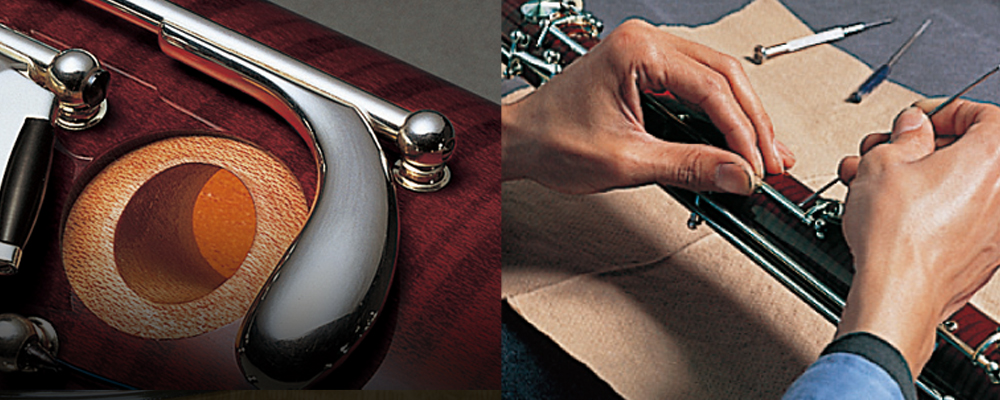How a Bassoon is Made
Making the pipe body
Made from hard maple wood
Bassoons produced today are made using hard maple mostly from Europe. Among the maple wood available, particularly hard wood is selected. That said, it is soft compared to the grenadilla wood used for making clarinets. When played for an extended period, moisture from the breath is absorbed, making it impossible for the joints to be separated, so care is needed.
Finishes
The color of the instrument's finish varies depending on the manufacturer, and instruments are available in colors that range from ochres to dark russets that look almost black. Yamaha bassoons are generally available in reddish russet finishes. Time is taken in the Yamaha workshop to build up layers of lacquer, allowing each coat to dry thoroughly, for a high quality finish.

Maple lumber cut to the size of the bell joint

Color of the wood surface before lacquer is applied

The russet color of the lacquered surface
Half a day to manufacture, cutting each tone hole with care
In addition to tone holes, the body of a bassoon needs many grooves and holes, for setting key posts and other metal fixtures, and since these are various sizes and shapes, a wide variety of cutting tools are required for use during manufacturing. Using such tools as needed, manufacture can take more than half a day for each bassoon. After cutting, the interior is treated with oil to protect against cracks and breakage.

Various cutters used during manufacture
Tone holes cut obliquely?
Because the body of a bassoon is such a complex shape, it is necessary to cut the tone holes with an exceptionally high level of precision. For example, because the double joint contains two sections of the bore, it is necessary to cut the tone holes not perpendicular to the surface of the body but obliquely. Also, for large bassoons, cutting tone holes obliquely is necessary to keep the space between tone holes within an appropriate range. Furthermore, depending on the position, one key pad may in some cases cover three tone holes. The alignment and covering of tone holes is very precise on the bassoon.

Double joints that have been finished externally, before internal work is completed

The tenor joint and its unique shape
Pads also in a variety of sizes
Because the sizes of tone holes vary, the pads that cover them also come in a variety of sizes. Materials such as felt or cardboard, wrapped in leather made from goat, sheep or cattle skin, are used to make the pads.

Pads
Musical Instrument Guide : Bassoon Contents
Structure
- What Kind of Musical Instrument is a Bassoon?
- A Long Tube that can be Separated
- The Bocal and its Various Functions
- Unique Features of the bassoon, and How to Play
- [Experiment1]Comparing the Sound of Tone Holes cut Obliquely and Perpendicular
- [Experiment2]Encasing the Bore in Various Materials
- Bonus Experiment
How to Play
How the Instrument is Made
Choosing an Instrument
Trivia
- An Instrument that is Sensitive to Humidity
- Sounds from water in the U-tube?
- There's a needle in the bocal?!
- Comments by conductors caused popularity to tumble?
- Bassoon classics - Chamber music works
- Bassoon classics - Concertos
- Is the "contra-fagotto" a contrabassoon?
- What is the best tool to file a reed?

